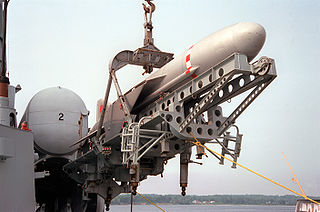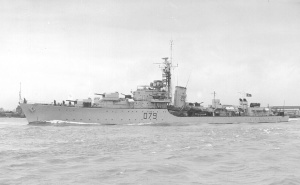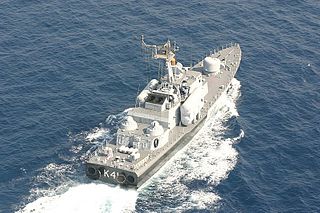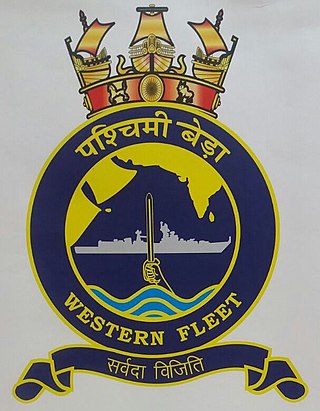
The P-15 Termit is an anti-ship missile developed by the Soviet Union's Raduga design bureau in the 1950s. Its GRAU designation was 4K40, its NATO reporting name was Styx or SS-N-2. China acquired the design in 1958 and created at least four versions: the CSS-N-1 Scrubbrush and CSS-N-2 versions were developed for ship-launched operation, while the CSS-C-2 Silkworm and CSS-C-3 Seersucker were used for coastal defence. Other names for this basic type of missile include: HY-1, SY-1, and FL-1 Flying Dragon, North Korean local produced KN-1 or KN-01, derived from both Silkworm variants and Russian & USSR P-15, Rubezh, P-20 P-22.

HMS Cadiz was a Battle-class destroyer of the Royal Navy. She was named after the Battle of Cádiz, in which the French besieged the Spanish town in 1810, which was eventually lifted in 1812 after the French defeat at the Battle of Salamanca.

A missile boat or missile cutter is a small, fast warship armed with anti-ship missiles. Being smaller than other warships such as destroyers and frigates, missile boats are popular with nations interested in forming a navy at lower cost. They are similar in concept to the torpedo boats of World War II; in fact, the first missile boats were modified torpedo boats with the torpedo tubes replaced by missile tubes.

Operation Trident was an offensive operation launched by the Indian Navy on Pakistan's port city of Karachi during the Indo-Pakistani War of 1971. Operation Trident saw the first use of anti-ship missiles in combat in the region. The operation was conducted on the night of 4–5 December and inflicted heavy damage on Pakistani vessels and facilities. While India suffered no losses, Pakistan lost a minesweeper, a destroyer, a cargo vessel carrying ammunition, and fuel storage tanks in Karachi. Another destroyer was also badly damaged and eventually scrapped. India celebrates its Navy Day annually on 4 December to mark this operation. Trident was followed up by Operation Python three days later.
Operation Python, a follow-up to Operation Trident, was the code name of a naval attack launched on West Pakistan's port city of Karachi by the Indian Navy during the Indo-Pakistani War of 1971. After the first attack during Operation Trident on the Port of Karachi, Pakistan stepped up aerial surveillance of its coast as the presence of large Indian Navy ships gave the impression that another attack was being planned. Pakistani warships attempted to outsmart the Indian Navy by mingling with merchant shipping. To counter these moves, Operation Python was launched on the night of 8/9 December 1971. A strike group consisting of one missile boat and two frigates attacked the group of ships off the coast of Karachi. While India suffered no losses, Pakistani fleet tanker PNS Dacca was damaged beyond repair, and the Kemari Oil Storage facility was lost. Two other foreign ships stationed in Karachi were also sunk during the attack.

The Veer-class corvettes of the Indian Navy are a customised Indian variant of the Soviet Tarantul class. They form the 22nd Killer Missile Vessel Squadron.
The Vidyut-class missile boats of the Indian Navy were an Indian variant of the Soviet Osa I class.
INS Veer (K82) (Brave) was a Vidyut-class missile boat of the Indian Navy.
INS Vidyut (K83) (Lightning) was the lead vessel of her class of fast attack craft of the Indian Navy.
INS Vijeta (K84) (Victor) was a Vidyut-class missile boat of the Indian Navy.
INS Nipat (K86) was a Vidyut-class missile boat of the Indian Navy. It was part of the 25th "Killer" Missile squadron.
INS Nashak (K87) (Destroyer) was a Vidyut-class missile boat of the Indian Navy.
INS Nirbhik (K88) (Fearless) was a Vidyut-class missile boat of the Indian Navy. It was this ship that the first missile launch was done to demonstrate to the then Prime Minister, Defence Minister and other dignitaries. The missile was launched by Lt. G. Sri Rama Rao.
INS Nirghat (K89) was a Vidyut-class missile boat of the Indian Navy.
The following ships of the Indian Navy have been named INS Vinash:
The Indo-Pakistani Naval War of 1971 refers to the maritime military engagements between the Indian Navy and the Pakistan Navy during the Indo-Pakistani War of 1971. The series of naval operations began with the Indian Navy's exertion of pressure on Pakistan from the Indian Ocean, while the Indian Army and Indian Air Force moved in to choke Pakistani forces operating in East Pakistan on land. Indian naval operations comprised naval interdiction, air defence, ground support, and logistics missions.
PNS Muhafiz was an Adjutant-class minesweeper of the Pakistan Navy. It was built by the United States for transfer to Pakistan. PNS Muhafiz was sunk by a missile from INS Veer of the Indian Navy during the Indo-Pakistani War of 1971.
Lt. Com. Bahadur Nariman KavinaVrC was a prominent Indian naval officer, who was commanding officer of the INS Nipat. During the Indo-Pakistani War of 1971, Kavina was the chief architect of attack on the Port of Karachi and led the successful attack on Pakistani Navy headquarters.

The Western Fleet is a Naval fleet of the Indian Navy. It is known as the 'Sword Arm' of the Indian Navy. It is headquartered at Mumbai, Maharashtra on the west coast of India. It is a part of the Western Naval Command and is responsible for the naval forces in the Arabian Sea and parts of the Indian Ocean.
Vice Admiral Elenjikal Chandy Kuruvila, PVSM, AVSM was a former Flag officer in the Indian Navy. He was the Fleet commander of the Western Fleet during the Indo-Pakistani War of 1971, for which he was awarded the Param Vishisht Seva Medal. He later led the Southern Naval Area and then served as the Chairman and Managing Director of Mazagon Dock Limited.





